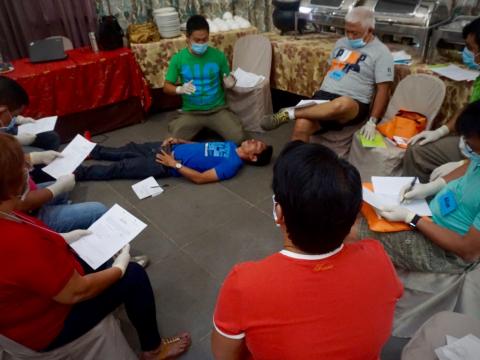Enabling local leaders as first responders

Grant Profile
Grant Project Name: Humanitarian Partnership Agreement Disaster Risk Reduction - Disaster Risk Management Capacity Building Activities - Extension
Funded by: Australian Department of Foreign Affairs and Trade
Time frame: October 2014 - June 2016
Purpose and objective: The project will strengthen the resilience of urban communities and schools against disasters. It focuses on capacitating key Department of Education staff in the Philippines to have the knowledge and skills to implement disaster risk reduction activities through the Comprehensive School Safety framework. In the areas where the project is implemented, relationship among educators, local government officials and other stakeholders, including children, is also strengthened to ensure that hazard-prone schools have enhanced capacity to manage disaster risk.
Mardie, one of the barangay health workers in Alcantara, Cebu joins the emergency medical responders' training after taking part in the development of her community's disaster risk reduction plan.
Philippines - Mingling with head teachers, Department of Education coordinators and nurses, Mardie Libato is not at all intimidated. A barangay health worker in her town in Alcantara, Cebu, she has learned to actively participate in activities that enable her to carry out her tasks in the community.
"If you would ask me to join this kind of training 10 years back, I wouldn't have said yes. I didn't think I could catch up especially with the composition of trainees," she grins.
But the different leadership exposure she’s had has eventually built her confidence. She now sits with different people from different professions as one of the 30 participants in the emergency medical responder training. The activity will equip educators and local leaders in first aid and basic life support.
On Disaster Risk Reduction awareness
Things particularly changed for Mardie and her community after Typhoon Jangmi hit her village in December 2014. She said that people didn't know where to evacuate. Everyone, including her family could only pray that they be spared from the wrath of the typhoon. Fortunately, they survived.
"I almost lost my husband and my father-in-law. The water from the river was unstoppable and the strong current swamped them," she recalls.
After the typhoon, the local government and NGOs, including World Vision, started strengthening disaster preparedness in the area. Aside from the barangay child-focused disaster risk reduction training, World Vision also conducted school-based DRR, recognizing that children are the most vulnerable during disasters.
"I took part in the village hazard mapping. Working with the community members including children, we were able to identify which areas in our neighborhoods are safe and unsafe during disasters. Now we can say that should there be another disaster like typhoon Jangmi, we are ready," Mardie adds.
Progressive training for local leaders
After the CFDRR training, her community was able to come up with a DRR plan. The plan, however, would need equipped leaders who are ready to implement DRR initiatives all year round.
"We understand how crucial a DRR plan is but we also find it necessary to equip local leaders like Mardie, who are the first responders during disasters. This is why we have involved them in the basic life support training," says Florabel Labor, Disaster Risk Reduction Specialist in Visayas.
Rhee Telen, Project Development Officer at the Cebu Provincial Disaster Risk Reduction Management Office lauded World Vision for such initiative.
Rhee shares, "It is our mandate to promote resilience throughout the city but we surely can't do it on our own. After this training, these participants will be included in our pool of responders who can help us not only during disasters but also in our preparedness initiatives."
She further emphasized that their office is six hours away from North and South Cebu, making it crucial for them to link and form a broad network of local responders in various locations to serve as their extended arms during disasters.
"I am now more confident in carrying out my task as a health worker in case a big disaster strikes. The training was overwhelming but I learned a lot. Last year’s scenes, when my husband and father-in-law struggled for their lives and when I and my neighbours were desperately wondering where to seek shelter would be the last time I would see myself, family and community, feeling lost and helpless," shares Mardie.